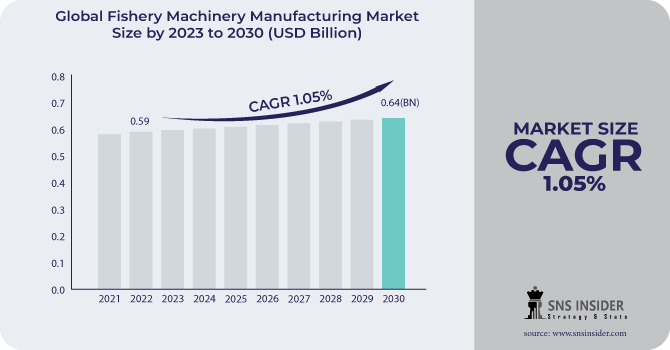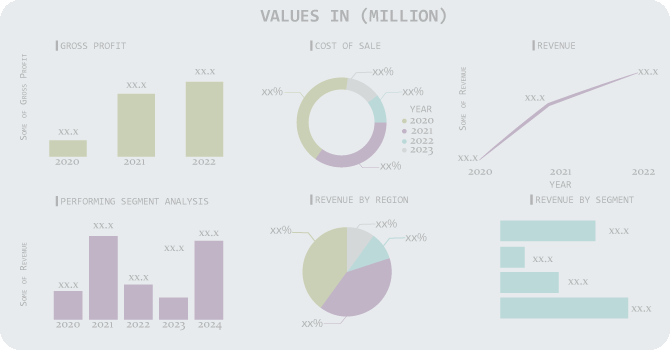Fishery Machinery Manufacturing Market Report Scope & Overview:
The Fishery Machinery Manufacturing Market size was USD 0.59 billion in 2022 and is expected to Reach USD 0.64 billion by 2030 and grow at a CAGR of 1.05% over the forecast period of 2023-2030.
Fishery machinery manufacturing is the process of designing, developing, and producing fishing machinery. Fishery machinery includes elevators and hoppers, feeders, head-cutting machines, filleting machines, and skinning machines.

Based on Application, the market is categorized as Agriculture, Aquaculture, Water Treatment, and Other applications. The aquaculture industry dominates the fisheries machinery manufacturing market. Aquaculture is the cultivation of aquatic creatures like fish, shrimp, and crustaceans. It is one of the world's fastest-growing food-producing areas. The aquaculture industry's expansion is pushing up demand for fisheries machinery. Governments all across the world are also encouraging the growth of the aquaculture business.
MARKET DYNAMICS
KEY DRIVERS
-
Increasing global demand for fish and seafood products
Fish and seafood are high in protein and other critical components, and they are gaining popularity around the world. This is because of a variety of variables, including People becoming more aware of the health advantages of consuming fish and seafood, which is driving up demand. To address the increased demand for fish and seafood products, manufacturers of fishing machinery are creating new and innovative technology. Some manufacturers are developing automated fishing machinery that can help enhance operational efficiency and production. Furthermore, several firms are creating machinery that will aid in reducing the environmental impact of the fishing sector.
-
Benefits of consumption of fish
RESTRAIN
-
Environmental concerns
Overfishing is the depletion of fish stocks to the point where they can no longer reproduce. This can result in the extinction of fish populations and ecosystems. Bycatch refers to the unintentional capture of non-target species including dolphins, turtles, and seabirds. Bycatch can cause the extinction of these species and disturb marine ecosystems. Coral reefs, seagrass beds, and other marine environments can be harmed by fishing gear. All these activities can lower marine ecosystem biodiversity and make them less responsive to disruptions.
-
Harmful water activities that cause imbalance in nature
OPPORTUNITY
-
Developing sustainable fishing machinery
Consumers and governments are both increasing their demand for environmentally friendly fishing equipment. Consumers are becoming more aware of the environmental impact of the fishing industry, and they are increasingly demanding sustainable seafood items fished or produced. Governments are also putting new policies in place to encourage sustainable fishing techniques. Some sustainable fishing equipment can help to prevent bycatch or the unintentional capture of non-target species. Other environmentally friendly fishing equipment can help to reduce fuel use and pollutants.
CHALLENGES
-
Skilled labor shortage
The manufacturing of fisheries machinery is a difficult and specialized sector that demands competent personnel. Workers in this industry must be well-versed in engineering, manufacturing, and fishing techniques. The scarcity of competent workers makes it difficult for fishing machinery producers to meet the rising demand for their products. Furthermore, the skilled labor scarcity makes it difficult for manufacturers to expand their operations.
IMPACT OF RUSSIA-UKRAINE WAR
The Russian war against Ukraine has had a significant influence on the Fishery Machinery Manufacturing Market. Many EU fishermen are docking their boats and warning of a fresh fish crisis. The war has had a direct impact on Black Sea fisheries, particularly for Romanian vessels that used to fish close to Ukrainian waters but are now urged to avoid the combat zone. Increased energy costs, as well as high logistic costs and trade interruption, are also affecting the aquaculture and fish processing industries. Although import limits do not apply to Russian seafood (except caviar and shellfish goods added in the fifth round of sanctions), trade flows remain significantly impeded, notably for EU fish-processing enterprises that rely largely on Russian supplies of whitefish. Thus, The Food and Agriculture Organization of the United Nations (FAO) predicts that the war in Ukraine will cause a 10% reduction in global business in fishing machinery in 2023.
IMPACT OF ONGOING RECESSION
Russia's invasion of Ukraine has led to a further escalation in energy costs. Also, the recession has fuelled the impact on the Fishery Machinery Manufacturing Market. The recession is causing businesses to delay or cancel investments in new fishery machinery, and it is also leading to a decline in consumer spending on fish and seafood products. Fisherman are having a hard time due to the high cost of fueling up their boats and paying a crew while carrying fishery activities. Fishing business is down by 75% as the economic downturn has led to fewer people ordering from restaurants.
MARKET SEGMENTATION
By Type
-
Elevators & hoppers
-
Feeders
-
Head cutting machines
-
Filleting machines
-
Skinning machines
By Application
-
Agriculture
-
Aquaculture
-
Water Treatment
-
Other
.png)
REGIONAL ANALYSIS
Asia Pacific is the dominant market for fishery machinery manufacturing which is attributed to technical improvements in regional in the food industry that promote market expansion. Due to the cheap labor costs connected with manufacturing machinery in these areas, Western producers of fishing equipment have been relocating their production bases to Asian countries like China and Indonesia. China is one of the markets for fishing machinery that is expanding fast due to the government's increased efforts to encourage industrialization.
North America is the world's second-largest market for fishing equipment. The region is home to some of the most current fishing enterprises in the world, including those of the United States and Canada. The need to boost efficiency and production, as well as improve the quality of fish and seafood products, drives demand for fishing machinery in the region.
Europe region is witnessing robust growth at a strong rate due to a growing health-conscious population and high demand for fish and seafood. The necessity to produce high-quality fish and seafood products in compliance with stringent environmental standards is what is driving the need for fisheries equipment in the area.
Latin America is one of the fastest-growing markets for fishing machinery due to rising disposable income levels, particularly in the emerging nations of Brazil and Argentina.
REGIONAL COVERAGE
North America
-
US
-
Canada
-
Mexico
Europe
-
Eastern Europe
-
Poland
-
Romania
-
Hungary
-
Turkey
-
Rest of Eastern Europe
-
-
Western Europe
-
Germany
-
France
-
UK
-
Italy
-
Spain
-
Netherlands
-
Switzerland
-
Austria
-
Rest of Western Europe
-
Asia Pacific
-
China
-
India
-
Japan
-
South Korea
-
Vietnam
-
Singapore
-
Australia
-
Rest of Asia Pacific
Middle East & Africa
-
Middle East
-
UAE
-
Egypt
-
Saudi Arabia
-
Qatar
-
Rest of Middle East
-
-
Africa
-
Nigeria
-
South Africa
-
Rest of Africa
-
Latin America
-
Brazil
-
Argentina
-
Colombia
-
Rest of Latin America
KEY PLAYERS
Some major key players in the Fishery Machinery Manufacturing Market are Bass Pro Shops, Berkley Fishing, AFTCO Mfg. Co. Inc., Buck’s Bag Inc., Bass Pro Shops, Pure Fishing, Inc., Aarcom International, Arenco AB, GEA Group Aktiengesellschaft, KM Fish Machinery A / S, Norfab Equipment Ltd., Aquaculture Equipment Ltd, Reef Industries, Inc., and other key players.
Bass Pro Shops-Company Financial Analysis

RECENT DEVELOPMENTS
In 2023, NaturalShrimp, Inc. developed and patented the first commercially operating shrimp-focused RAS, and has inked a licensing agreement with Niterra Co., Ltd. NaturalShrimp's proprietary shrimp-growing technology will be tested under the terms of the agreement.
In 2023, Publix donated to the Sustainable Fisheries Partnership to help protect ocean wildlife. The donations this year raised the company's total contributions to more than $600,000 throughout their 13-year partnership with Sustainable Fisheries Partnership (SFP).
| Report Attributes | Details |
| Market Size in 2022 | US$ 0.59 Billion |
| Market Size by 2030 | US$ 0.64 Billion |
| CAGR | CAGR of 1.05 % From 2023 to 2030 |
| Base Year | 2022 |
| Forecast Period | 2023-2030 |
| Historical Data | 2019-2021 |
| Report Scope & Coverage | Market Size, Segments Analysis, Competitive Landscape, Regional Analysis, DROC & SWOT Analysis, Forecast Outlook |
| Key Segments | • By Product (Elevators & hoppers, Feeders, Head cutting machines, Filleting machines, Skinning machines) • By Application (Agriculture, Aquaculture, Water Treatment, Other) |
| Regional Analysis/Coverage | North America (US, Canada, Mexico), Europe (Eastern Europe [Poland, Romania, Hungary, Turkey, Rest of Eastern Europe] Western Europe] Germany, France, UK, Italy, Spain, Netherlands, Switzerland, Austria, Rest of Western Europe]), Asia Pacific (China, India, Japan, South Korea, Vietnam, Singapore, Australia, Rest of Asia Pacific), Middle East & Africa (Middle East [UAE, Egypt, Saudi Arabia, Qatar, Rest of Middle East], Africa [Nigeria, South Africa, Rest of Africa], Latin America (Brazil, Argentina, Colombia Rest of Latin America) |
| Company Profiles | Bass Pro Shops, Berkley Fishing, AFTCO Mfg. Co. Inc., Buck’s Bag Inc., Bass Pro Shops, Pure Fishing, Inc., Aarcom International, Arenco AB, GEA Group Aktiengesellschaft, KM Fish Machinery A / S, Norfab Equipment Ltd., Aquaculture Equipment Ltd, Reef Industries, Inc |
| Key Drivers | • Increasing global demand for fish and seafood products • Benefits of consumption of fish |
| Market Restrain | • Environmental concerns • Harmful water activities that cause imbalance in nature |

